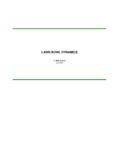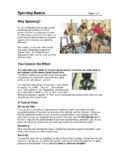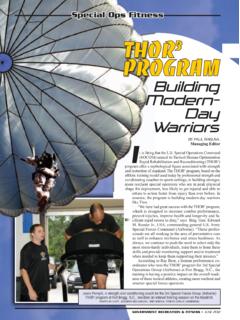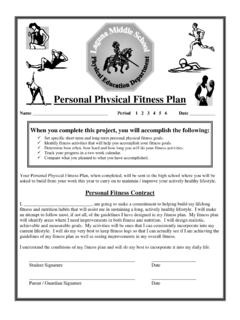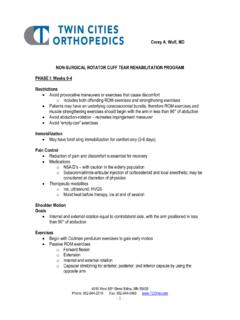Transcription of PHYSICAL FITNESS FOR LAWN BOWLING - Sun City Lawn …
1 PHYSICAL FITNESS FOR lawn BOWLING by Rob Judson September 2002 PHYSICAL FITNESS For lawn BOWLING Page 2 General FITNESS and Health lawn bowls imposes lower PHYSICAL demands than many other sports impose on players. The general physiological requirements of lawn bowls are good general health and a well-functioning cardio-vascular system. Playing of several competitive games on each of several consecutive days would clearly make greater PHYSICAL demands on bowlers than one social game per day.
2 Elements of PHYSICAL FITNESS of most benefit are endurance and limb flexibility. Any training undertaken does not necessitate high intensity work. Partly because of their average age, few bowlers undertake FITNESS training. Those bowlers who do undertake FITNESS training, need to be aware of the recommended maximum heart rate for their age. It is 208 - age (in years). So a 60-year-old bowler should avoid activities that could cause heart rate to rise above 208 - 42 = 166 beats per minute.
3 In general, bowlers of or above middle age should aim for a heart rate about 2/3rds of the maximum for their age during training. Because the sport does not require a high degree of PHYSICAL conditioning, some bowlers mistakenly believe either that PHYSICAL FITNESS does not provide a competitive advantage, or that unfitness is not a disadvantage. In games between bowlers of similar competence but differing FITNESS levels, the fitter bowler tends to have a competitive edge. Adverse lifestyle habits that affect PHYSICAL capacity for competitive BOWLING include: smoking, alcohol, obesity, insufficient sleep, and non-prescribed pharmaceuticals.
4 Bowlers should appreciate the effects of these, even though they might be reluctant to avoid adverse indulgences. Excess body weight is a condition that commonly affects performance, FITNESS and health. The Body Mass Index (BMI) of an individual takes into account height and body weight. The BMI is the weight expressed in kilograms divided by the height (in metres) squared. In short, BMI = W H2. The appended table shows BMIs according to the column that corresponds with height, and the row that corresponds with body weight.
5 (Weights expressed in pounds need to be divided by to convert them to kilograms). The ideal range for BMI is between 20 and 25. Bowlers with BMIs between 25 and 30 are generally overweight. Bowlers with BMIs exceeding 30 are generally obese and should consider losing weight. Bowlers with BMIs between 18 and 20 are generally underweight. Bowlers with BMIs under 18 should consider gaining enough weight to enter the ideal range. Warm Up & Stretching Warm Up Trial ends, though useful, are inadequate as a warm up for bowlers.
6 As a result, bowlers tend to be less effective until they have warmed up and acquired full joint flexibility. Warm up is the process of physiologically preparing for BOWLING . Warming up for bowls requires brief gentle exercise ( walking) to stimulate the circulation rate and warm joints and muscles. The muscular-skeletal system thereby functions more efficiently and has less likelihood of sustaining injury. Warming up dissipates any stiffness. It prepares a bowler's body for controlled and accurate movements from the outset.
7 It also tends to induce a relaxed and ready state of mind. Stretching A slow start is not a good way to begin a competition. Pre-game static stretching is the solution to this problem. Stretching exercises should be effective, quick, simple, and reasonably unobtrusive It takes only a couple of minutes to stretch all muscles important for BOWLING . Static stretching involves flexing or extending each major muscle group in turn and holding it at the limit of its normal range of movement for about six seconds before allowing it to relax.
8 Stretching should avoid discomfort and any ballistic movements. Bowlers should breathe deeply while stretching. PHYSICAL FITNESS For lawn BOWLING Page 3 The Australian bowls coaches' manual details a range of stretches for the major muscles of the legs, back , arms and neck. The stretching process for bowls should include gentle working of major muscle groups. A good choice of stretches would not require any equipment, nor result in soiling of BOWLING attire. Even just before a competition, bowlers should find enough time to: circle the extended delivery arm forwards & backwards 8-10 times each way while standing, hug each knee towards the chest flex and loosen knees and ankles.
9 Before a practice session, bowlers should have ample time for stretching. Two stretches for the arms follow. On the left, the bowler extends the arms behind the back and clasps hands. Raising of the arms stretches the muscles in the chest and upper arms. A similar stretch involves extending the arms forward with wrists crossed and palms clasped together. The bowler raises the arms to an overhead position and then returns them to the start position. On the right, the bowler has arms in the forward position.
10 However, the exercise there comprises using the non- BOWLING hand as a resistance for flexing and extending the fingers and wrist of the BOWLING hand. Two stretches for the upper arms and shoulders follow. On the left, the bowler demonstrates a latissimus dorsi stretch. This muscle provides much of the power for the back swing of a bowl. A bowler places the BOWLING hand (in this case, the left hand) behind the neck or extending down the back , and pulls on the elbow with the non- BOWLING hand.
